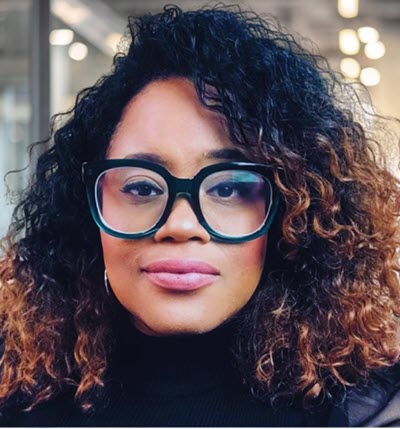There's No Such Thing as An Average Software User: What it Means to Design for Inclusion

Designing software to be human-friendly is a challenge because humans do things differently, have different needs, and use tools based on what they're trying to do and the most comfortable way to do it for them. As individuals, there's usually a choice about the software you download and use. But at work, the software has to work for everyone as much as it can.
When we talk about designing for inclusion, what does that mean?
GM: It means that we think about as many people as possible and consider what they might need or want to use our products. There's no such thing as an average software user. When we launch one-size-fits-all software, it's a lot like clothing. One size never really fits all and often doesn't even work for most people.
Clothing has many examples of inclusive design. Take bathing suits as an example: there are options available for different body sizes, body shapes, ages, disabilities, genders, values/faith practices, and even options that left-handed people can navigate more easily. Rather than a one-size-fits-all, even clothing can be designed for all types of people.
Software is kind of like that, too. Instead of sizes, we add features and options so it fits as many people as possible in ways that are both comfortable and work.
How do you do that? How is it possible to imagine everything someone might need and then figure out how to make it part of the program?
GM: At ADP, we build products for everyone. We do our best and go as far as we can to bring designs that are useful and comfortable for anyone who uses them.
But we don't do it in a vacuum of trying to figure out everything we could possibly do or ever want. We start by researching who our current and potential customers are, where they are, their cultural and environmental factors, when and how they work, and what they're trying to do and why.
That research goes beyond specific individual needs and takes a more expansive view of the questions we should ask and the other information we might need.
We start with a big picture, but not an unlimited one. And we keep an open perspective. When we learn about one possible issue or need, we often discover others we had not initially considered.
Then, we can start to identify potential issues as they relate to the software and consider how they might be addressed. Sometimes, we need to talk to people with lived experience to help us better understand the issues and how we can help.
We also consider more specific needs based on physical and other factors and how those can be addressed. For example, we ask if this approach will work for someone left-handed or sensitive to certain kinds of light, organization, or design.
It's a complex and dynamic process that takes curiosity, open-mindedness, and care in addition to designing and building great software.
Above, Giselle Mota, ADP Chief of Product Inclusion, outlines three steps to making sure everyone is represented when designing an innovative new product. Continue reading for the rest of the interview.
Everyone deserves tools that work well and are comfortable to use. Why else does inclusive design matter?
GM: Inclusive design supports the things our clients need. An important example is compliance. Compliance is essential for organizations, but compliance means different things everywhere. Many of our clients are global, and our products must work within their human rights and employment laws.
An important part of product inclusion at ADP is to partner closely with our experts on compliance, privacy, and legal because inclusion and compliance are often related. For example, while an organization has to report on gender in the U.S. to remain in compliance with EEOC reporting, there is an option to include the non-binary gender in the comments; the ability for organizations to access that voluntary data comes from our inclusive design.
Sometimes, where compliance ends, inclusion picks up and goes beyond—it's one thing to make a reasonable accommodation for a specific person under the ADA and another to design and innovate for and with people with all kinds of disabilities.
How do you expand these concepts to your global clients where law, culture, and how and when people work can vary widely?
GM: It requires having great global teams and many different considerations. For example, some of our international clients operate in countries where gender identity may not be legally recognized and having nonbinary options may put employees in an uncomfortable or unsafe position.

Giselle Mota, ADP Chief of Product Inclusion
Some organizations move to make programs and policies available for the culture of their local office in that country, supporting events and daily work experiences and acknowledging their people with something as seemingly minor as giving them the option to share the name they prefer or choose to be referred to.
Related to this is that our global clients are diverse and have specific needs related to their cultures, beliefs, and the ways they work. Designing to meet as many needs as possible increases their ability to serve their customers more effectively and increase market share.
And both our clients and their clients care about inclusion at the level of their preparedness. Some organizations go all in for disability inclusion and are not quite ready for genders or vice versa. The one thing that rings true for everyone is that regardless of preparedness, there is demand for inclusion and market potential, as proved by the spending power of demographics. The one billion global population of people with disabilities has about $1 trillion in spending power. In the U.S., the spending power of various demographic groups includes:
- Latino: $1.7 trillion
- LGBTQ+: $917 billion
- Black: $1.4 billion
When people understand and experience having their needs met, they stay customers and tell their colleagues at other organizations. Inclusive design is good for business and good for everyone.
Learn more
Whether your business is large or small, inclusive practices can help improve your employees' experience and your bottom line.
Our product inclusion page has a complimentary product inclusion guide and other resources to help your organization become an inclusive place where everyone feels like they belong.



